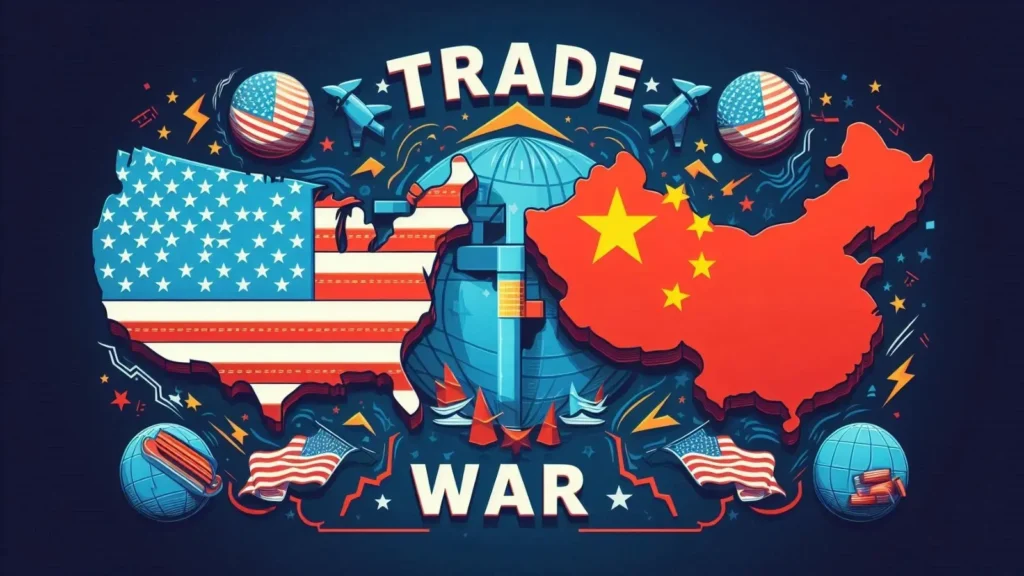When two economic giants clash, the whole world feels the tremors.
What started as a series of tariff hikes between the U.S. and China has now evolved into a global power struggle affecting everything from the price of your morning coffee to the fate of small businesses across continents.
But what’s really going on behind the headlines? And more importantly, how does it impact you? In this deep dive, we unravel the ongoing trade war, the latest real stories behind the tariffs, and how this economic tug-of-war is quietly rewriting the rules of global commerce.
This is the story of how tariffs became tools of power and how they continue to reshape our world.

Chapter 1: A Tipping Point in April 2025
In a bold and unexpected move, the U.S. government under President Donald Trump announced a 104% tariff on Chinese imports. This drastic measure was framed as a response to China’s earlier imposition of a 34% tariff on U.S. goods.
Treasury Secretary Scott Bessent described China’s move as a “strategic misstep,” pointing to the ongoing trade imbalance between the two economic giants. China, in turn, rejected the U.S. move outright, calling it blackmail and vowing to “fight till the end.”
This marked a turning point in the U.S.–China tariff war, shifting it from a simmering standoff to an open confrontation.
Chapter 2: How Global Markets Reacted top U.S China Tariffs War?
The markets responded quickly—and not favorably. News of the tariffs triggered sharp declines across major financial indices:
- Germany’s DAX and France’s CAC 40 fell by over 2.5 percent
- Japan’s Nikkei 225 dropped 3.9 percent
- Taiwan’s Taiex suffered a steep 5.8 percent fall, with technology stocks like TSMC taking a major hit
This immediate reaction signaled how sensitive global markets are to shifts in trade policy. Investor confidence wavered, reflecting the growing fear of prolonged economic disruption.
Chapter 3: China’s Counterattack
China answered the U.S. tariffs with its own set of retaliatory measures. New tariffs ranging from 10 to 15 percent were placed on key American agricultural exports—including soybeans, pork, beef, and chicken—directly impacting U.S. farmers and agribusinesses.
In addition, several U.S. companies were added to China’s “unreliable entity list,” restricting their operations and market access within the country. This strategy highlighted China’s intention to target not only trade but also technology and corporate influence.

Chapter 4: The Real-World Impact of Tariffs
While governments argue and negotiate, the consequences of the tariff war are felt on the ground.
- Consumers are seeing rising prices on everyday goods
- Businesses are grappling with disrupted supply chains and unpredictable regulations
- Industries like agriculture, automotive, and technology are struggling to adapt
The uncertainty created by this trade war is also dampening economic growth projections worldwide. Analysts warn that if tensions persist, a broader economic slowdown could be inevitable.
Chapter 5: What the Future Might Hold
Despite the dramatic escalation, both the U.S. and China have expressed a desire to return to the negotiating table. However, deep-rooted issues remain—such as intellectual property rights, fair competition, and reciprocal market access.
The road to resolution is likely to be long and complex. The outcome of this economic standoff will shape trade relationships, manufacturing strategies, and geopolitical alliances for years to come.
Why This Trade War Matters
The U.S.–China trade war is more than just a clash between two nations. It’s a global issue that affects supply chains, stock markets, product pricing, and economic security. Whether you’re a small business owner, investor, or everyday consumer, the ripple effects of these decisions are already being felt.
Staying informed is no longer optional—it’s essential.
Follow this space for real-time updates, expert insights, and deeper analysis as the trade war unfolds. Because understanding global trade isn’t just for economists anymore—it’s for everyone.




